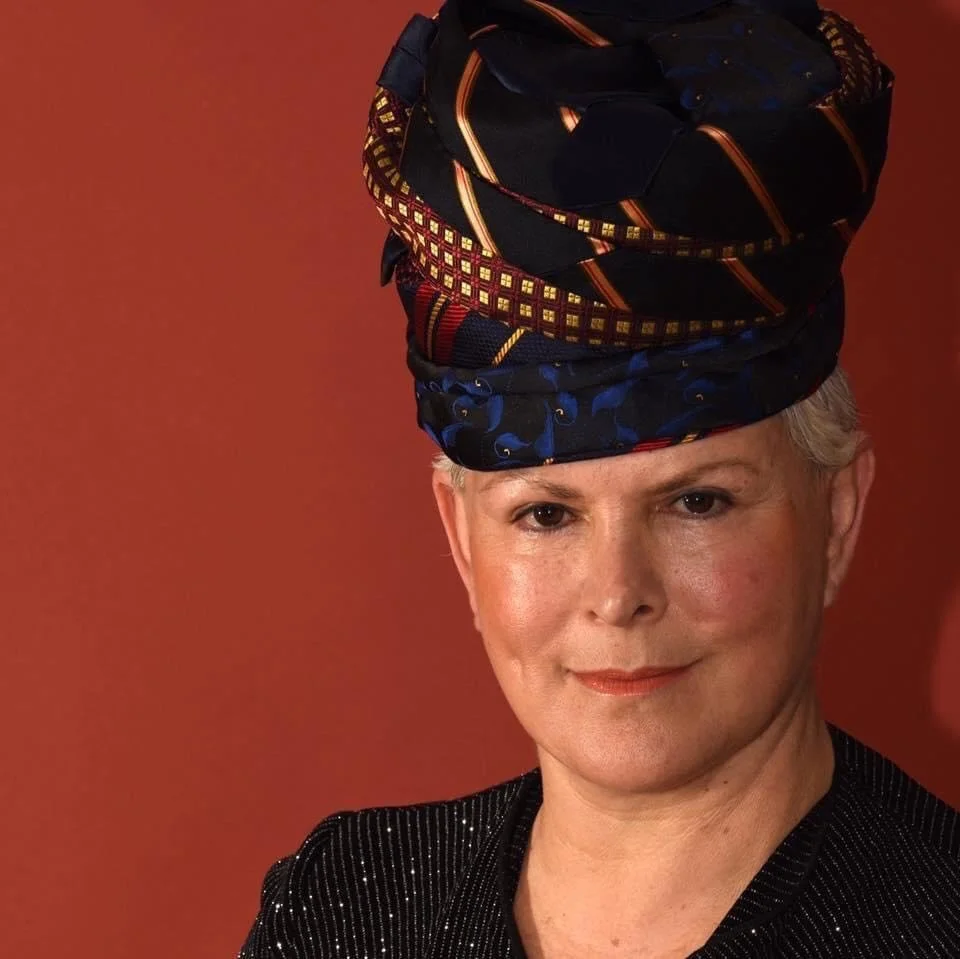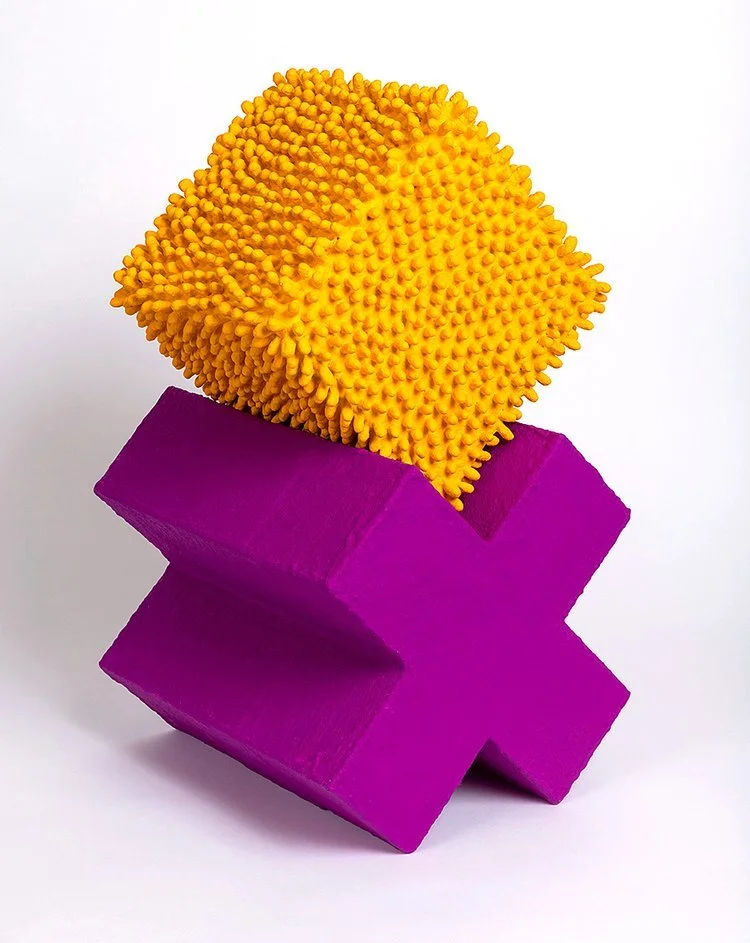10 Questions with Suly Bornstein-Wolff
Al-Tiba9 Art Magazine ISSUE11 | Featured Artist
Suly Bornstein-Wolff was born and raised in Sao Paulo, Brazil. She currently lives and works in Tel-Aviv, Israel.
The combination of two different cultures, worlds, and a sense of belonging influence her entire work. She has studied interior design at Ort School of Engineering, and for the past 30 years, she has devoted herself to art.
She creates objects, installations as well as paintings. Usually creating large-scale paintings, her subject varies from landscape to architecture, from figurative to abstract. Esthetics is a major focus in both her paintings and objects. By using readymade material, she emphasizes the quality and the beauty of the object, as if it was a jewel.
Suly Bornstein-Wolff - Portrait
ARTIST STATEMENT
Suly Bornstein-Wolff's work combines various everyday materials, including glass, ceramics, and canvas, into an organic whole.
Suly draws her motifs and inspiration from nature: textures of trees, flowers, plants, forms simulating waves, etc. A closer look at Suly's artistic endeavors reveals her idiosyncratic approach to aesthetic precision. The three-dimensional works surrender an extensive engagement with recycling and reuse. While recycling is often perceived as an act devoid of glamor, Suly work elevates the act of recycling through laborious practice and a carefully designed, rich, colorful syntax, uniting organic motifs into a work of art and craft, infused with a social-consumerist ideology.
Suly uses glass fixtures, such as lampshades, Murano and Bohemian glass, crystal, as well as porcelain jugs she collects. The combination of glasses from different centuries, made in diverse techniques, transforms a purposeful, functional material and image into a sculptural object while blending old and new, the functional and the decorative, manual labor and mass production.
Soft Vitrage is a meticulous collage series consisting of hundreds of cutouts in the shape of small leaves; these are, in fact, oil paintings on canvas made by the artist whom she decided to cut. This series is a tribute to Italo Calvino's novel Invisible Cities, which challenges the human imagination through descriptions of spectacular, fantastic, imaginative cities.
Solo exhibition installation view, photo by Avi Amsalem © Suly Bornstein-Wolff
INTERVIEW
First of all, introduce yourself to our readers. Who is Suly Bornstein-Wolff, and how would you describe yourself in three words?
I am a dreamer, a collector of visions.
Do you remember when you first realized you wanted to be an artist? Has anything changed in your mind since then?
I started to paint at a very early age. At the age of 5, I remember telling myself that I would be an artist. Since then, it has only become clearer, concrete, and intense.
Glass Objects © Suly Bornstein-Wolff
You were born in Brazil and currently live in Tel-Aviv. As you mention in your biography, "The combination of two different cultures, worlds, and sense of belonging influence my entire work." Tell us more about this influence and how it is reflected in your work.
My memories of my childhood in Brazil are an accumulation of a variety of bright tropical colors, Brazilian music, spices, and sumptuous international and Baroque architectures - all of which have been ingrained in me since childhood. My life changed overnight once I encountered Israel. The fusion with the local culture and temperament and the colors of the desert have created over the years a combination that influences my life and creation to this very day - I try to take the best of all worlds. And with years, I have found similarities that have become parts of my iconographic works. In Brazil, for example, eucalyptus and palm trees were part of my everyday landscape. Once, in Israel, I discovered the same plants, and these were an endearing and happy connection - I have often painted them till today.
You use different techniques and processes, working with painting and objects. How do you choose them, and how does your work change depending on the medium?
As a multidisciplinary artist, I am very close to representations of aesthetic values , beauty, and harmony in every work I create. When I choose to paint, I paint in oil colors, and the influence of Impressionism and artists, like Monet and Cezanne, accompanies my way of looking at the world and nature around me.
For the past fifteen years, alongside painting, I have been creating objects and installations that are almost purely made of readymade materials and materials that are about to be thrown in the trash. I collect them, and then I sort, clean, and create from them a new object with new life with meticulous and distinct aesthetics. It is important for me to express a message to the world, and to say through my art that one can create beauty from the negligible materials of everyday life. I'm interested and motivated to create works that are not only beautiful but have a social message to the affluent society that is engaged in producing goods and consuming them excessively. I call for creation from what already exists in the world.
How much planning goes into each series?
I don't plan the size of the series. It grows and develops, and sometimes I deal with the same subject or series for several years.
Soft Vitrage © Suly Bornstein-Wolff
Soft vitrage, 2021. Photo by Ran Erde © Suly Bornstein-Wolff
Soft vitrage, mixed media, diameter 90 cm, 2021. Photo by Avi Amslaem © Suly Bornstein-Wolff
What themes do you pursue? Tell us the messages you want to convey.
In my art, I express and deal with the topics of cyclical nature of the world of consumption that I fear has a horrific influence on the world balance and climate. One of the most important things I wish to convey through my art is the importance of recycling and upcycling; I'm inspired by the endless possibilities in eco-art. My works conduct an ongoing dialogue between arts and craft, between "high" and "low", that are translated in meticulous handwork into well-made objects.
What about your source of inspiration? Where did you get your imagery from, and is there any artist you particularly admire?
As a child, I was fascinated by Picasso, Monet, Van Gogh, and Rembrandt. Today I love and appreciate Kiki Smith, Louise Bourgeois as well as Anselm Kiefer, Anish Kapoor, and of course, designer Ingo Maurer.
Nature and life around me are my sources of inspiration. I came from a tropical country, and as a child, I experienced very powerfully the wildlife, the forests and trees, and flowers inspire me and my art till today.
Architecture and geometry – their form and volumes- also play a role in my art. The grid as a metaphor and as the very core of conceptual art is also entwined in many of my creations in paintings as well as in objects
How do you choose your materials and their impact on the final result?
I am a curious person; I like to search for sources of inspiration, to walk around the markets, the streets of my city, and the industrial areas. Every day materials and objects that have been forgotten or thrown away are a trigger for my research and creation. I collect materials like nylon hair-dresser aprons, miniature toys, magazines, perfume bottle caps, and more. In recent years I have also focused on glass objects and installations from readymade glass shades, glass vases, Murano Glass, Bavarian, and others that I collect in flea markets.
This large ongoing series of works conducts a dialogue between fine art and craft, expressing the cyclical nature of the world of consumer objects as seen through my eyes. I'm interested in connecting different materials, combining "high" and "low" features, and checking the thin line between art and craft. All are translated into well-made objects. Some are functional; some are "plainly" conversing with beauty and aesthetics.
For example, my series, "Knots", is made from used hairdressing aprons made of white plastic shits, which I collected after there were used. After cutting them into thin strips, I turn them into long chains made of many hand-made knots. Then I create inflorescence-like objects; some are in the shape of hairs, spheres, and flowers. In them, I explore diverse topics such as a maternal bond, umbilical cord relationship, friendship, mutual guarantee, and political ties.
View in studio, 2021. Photo by Ran Erde © Suly Bornstein-Wolff
On that note, are you experimenting with anything new these days? What do you think of NFTs and other recent developments in the art world over the past year, such as digital exhibitions and online viewing rooms?
Lately, I have been working with scraps of wood pieces I collect near factories and carpentry workshops. I am fascinated by the endless forms and shapes I can create and am creating design objects as well as art pieces such as wall assemblages.
I was commissioned to create a solo exhibition in Hiriya Recycling Park in the center of Israel. This project is very challenging and will open to the public by the middle of August 2022. In it, I have a unique opportunity to show many of my readymade objects and installations to the public and to many pupils of all ages.
I am not familiar enough with NFT for me to form an opinion about it. I think digital exhibitions and previews are a part of our life, and it is an ongoing way of experiencing art and other topics. We have come to realize it even more after the corona.
Lastly, what are your projects for the future? Do you have any upcoming exhibitions or long-term projects you want to share with our readers?
As I was saying, I am working on a big solo project that deals with recycled materials. Finding beauty in these materials and expressing my concept of using only what exists already in the world and not creating more materials is important. Later on, I am preparing a solo exhibition that will be shown in Milano. I am not allowed to say more than that. To be continued…























